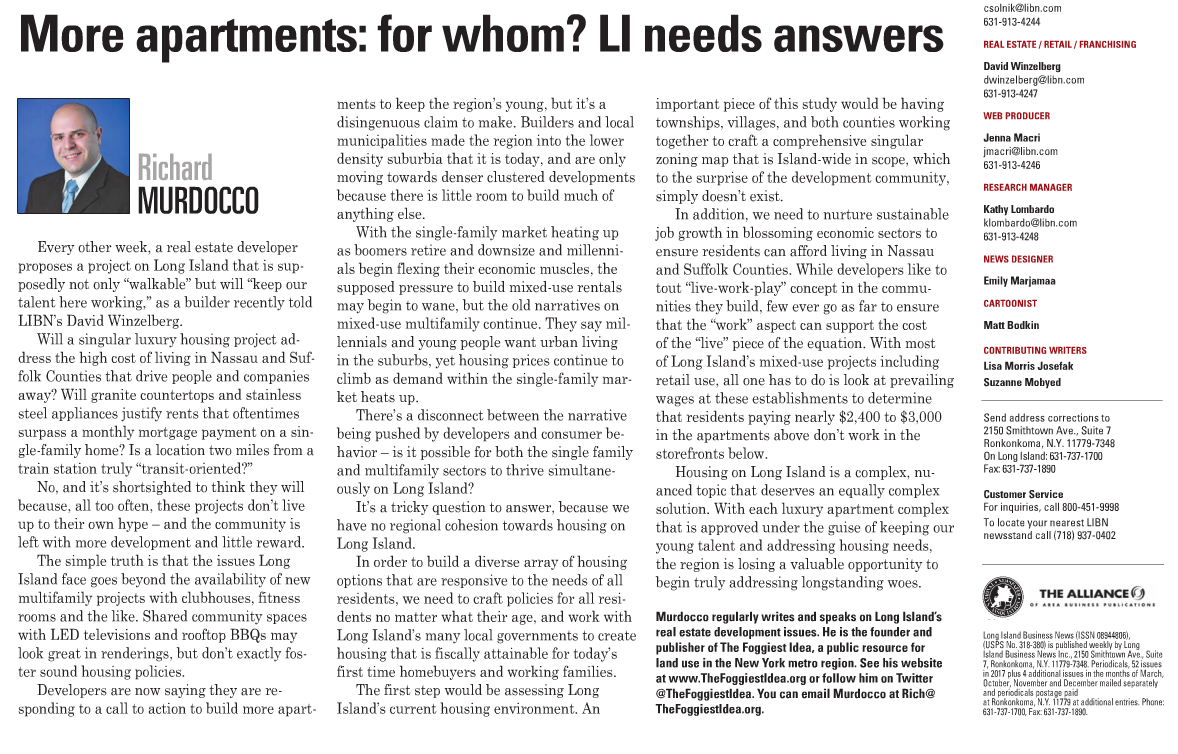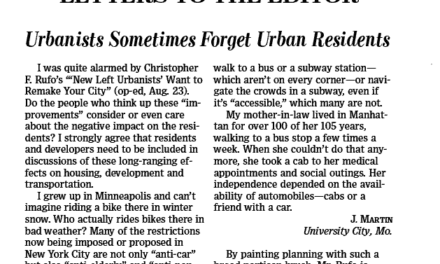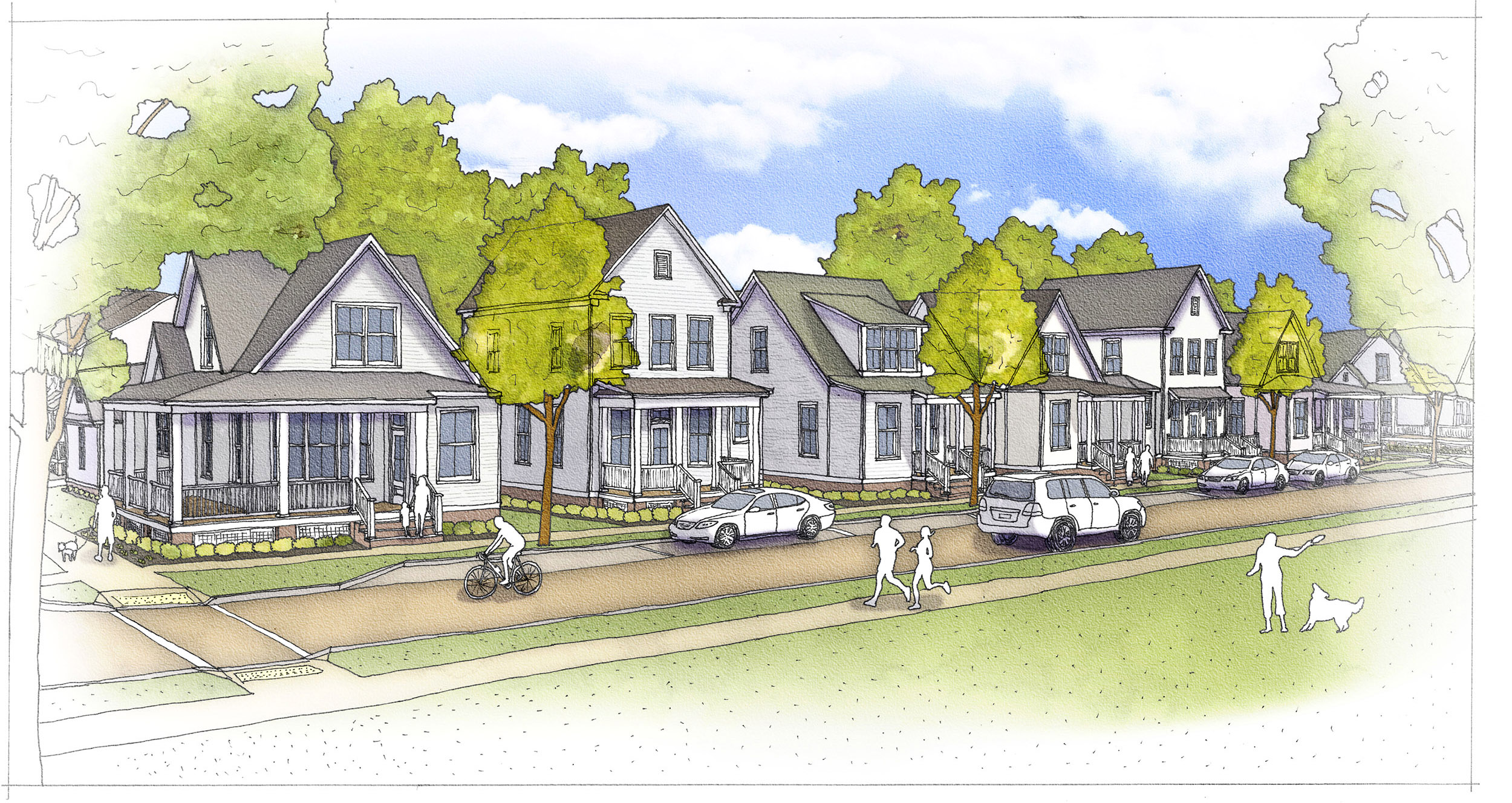The following op-ed was published in the June 2, 2017 edition of Long Island Business News. You can read the original here.
Every other week, a real estate developer proposes a project on Long Island that is supposedly not only “walkable” but will “keep our talent here working,” as a builder recently told LIBN’s David Winzelberg.
Will a singular luxury housing project address the high cost of living in Nassau and Suffolk Counties that drive people and companies away? Will granite countertops and stainless steel appliances justify rents that oftentimes surpass a monthly mortgage payment on a single-family home? Is a location two miles from a train station truly “transit-oriented?”
No, and it’s shortsighted to think they will because all too often, these projects don’t live up to their own hype – and the community is left with more development and little reward.
The simple truth is that the issues Long Island face goes beyond the availability of new multifamily projects with clubhouses, fitness rooms and the like. Shared community spaces with LED televisions and rooftop BBQs may look great in renderings, but don’t exactly foster sound housing policies.
Developers are now saying they are responding to a call to action to build more apartments to keep the region’s young, but it’s a disingenuous claim to make. Builders and local municipalities made the region into the lower density suburbia that it is today, and are only moving towards denser clustered developments because there is little room to build much of anything else.
With the single-family market heating up as boomers retire and downsize and millennials begin flexing their economic muscles, the supposed pressure to build mixed-use rentals may begin to wane, but the old narratives on mixed-use multifamily continue. They say millennials and young people want urban living in the suburbs, yet housing prices continue to climb as demand within the single-family market heats up.
There seems to be a disconnect between the narrative being pushed by developers, and consumer behavior – is it possible for both the single family and multifamily sectors to thrive simultaneously on Long Island?
It’s a tricky question to answer, because we have no regional cohesion towards housing on Long Island. In order to build a diverse array of housing options that are responsive to the needs of all residents, we need to craft policies for all residents no matter what their age, and work with Long Island’s many local governments to create housing that is fiscally attainable for today’s first time homebuyers and working families.
The first step would be assessing Long Island’s current housing environment. An important piece of this study would be having townships, villages, and both counties working together to craft a comprehensive singular zoning map that is Island-wide in scope, which to the surprise of the development community, simply doesn’t exist.
In addition, we need to nurture sustainable job growth in blossoming economic sectors to ensure residents can afford living in Nassau and Suffolk Counties. While developers like to tout “live-work-play” concept in the communities they build, few ever go as far to ensure that the “work” aspect can support the cost of the “live” piece of the equation. With most of Long Island’s mixed-use projects including retail use, all one has to do is look at prevailing wages at these establishments to determine that residents paying nearly $2,400 to $3,000 in the apartments above don’t work in the storefronts below.
Housing on Long Island is a complex, nuanced topic that deserves an equally complex solution. With each luxury apartment complex that is approved under the guise of keeping our young talent and addressing housing needs, the region is losing a valuable opportunity to begin truly addressing longstanding woes.
Richard Murdocco regularly writes and speaks on Long Island’s real estate development issues. He is the founder and publisher of The Foggiest Idea, a public resource for land use in the New York metro region, and received his Master’s in Public Policy at Stony Brook University, where he studied regional planning under Dr. Lee Koppelman, Long Island’s veteran master planner.
More of his views can be found on www.TheFoggiestIdea.org or follow him on Twitter @TheFoggiestIdea. You can email Murdocco at Rich@TheFoggiestIdea.org.











You got this one right, Mr. Murdocco. But, I have been trying to get this point across for years. Politicians and developers aren’t interested in affordable housing, keeping millennials here or catering to seniors. It’s all rhetoric. Uninformed residents have been brainwashed. The bottom line is “show me the money and votes” by developers, unions and politicians. Two story projects would probably have had less opposition from homeowners, as they would have fit in with the suburbia look; would not have affected our water and air quality, would not have overcrowded our schools, created less traffic than high rise, high density, and not have affected our quality of life. Perhaps massive sewer districts would not have been necessary, or massive infrastructure like the expansion of the LIE & Sagtikos Parkway predicted for the Heartland Town Square to accommodate 20,000 more residents, or third rail on the LIRR. Politicians, developers and unions went for the jugular of suburbanites without any concern for availability of career jobs for the tens of thousands expected to fill the apartments and pushing the narrative of TOD’s, which will never get people out of their cars on Long Island. There may still be time to stop Heartland Town Square, which will be decided by five Islip Town Board members, and probably not until after they have comfortably been re-elected, which leads me to believe they have already made their decision to pass the most massive project in the history of Long Island.